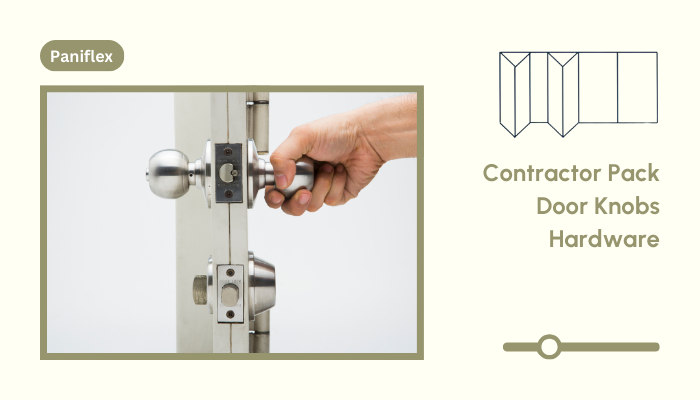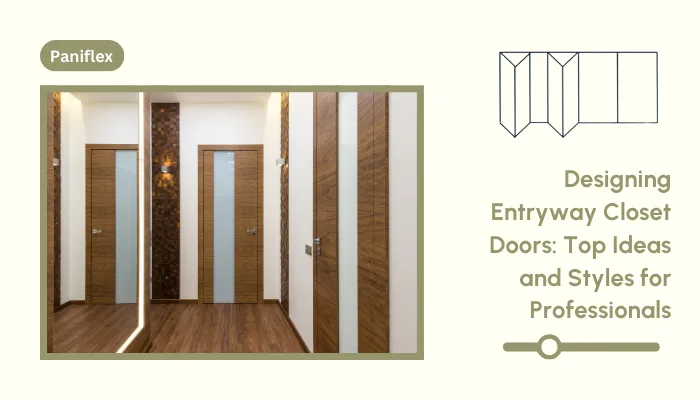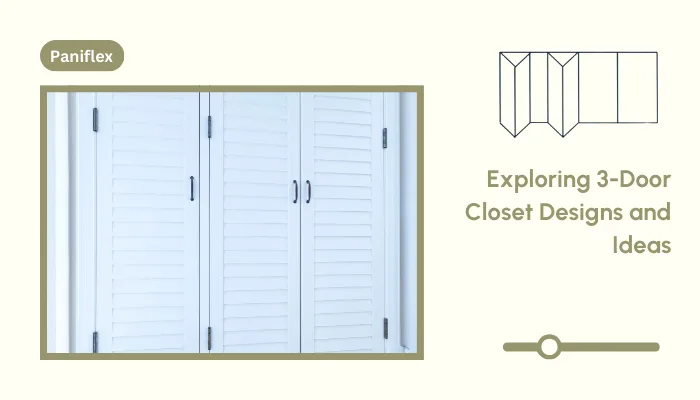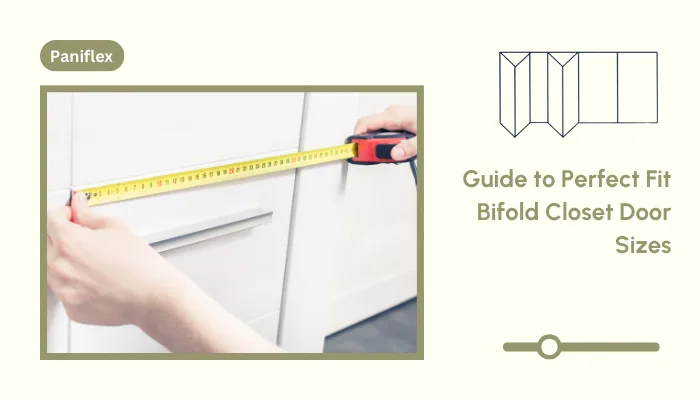In the world of construction and interior design, the importance of door hardware cannot be overstated. Door knobs, in particular, serve as both functional necessities and design elements that can significantly impact the overall aesthetic of a space. Contractor packs closet door knobs have emerged as a popular solution for large-scale projects, offering a perfect blend of practicality and style.
Manufacturers specifically design these packs to meet the needs of contractors, builders, and designers working on projects that require multiple sets of matching door hardware. By providing a bulk quantity of coordinated knobs, latches, and other essential components, contractor packs closet door knobs streamline the procurement process and ensure consistency across an entire project.
The use of contractor packs is particularly beneficial in multi-unit residential developments, commercial buildings, and large-scale renovations where time efficiency and cost-effectiveness are paramount. These packs not only simplify the ordering process but also contribute to a more cohesive and professional final result.
Components of Contractor Packs
Comprehensive solutions containing all the necessary components for a complete door hardware installation characterize contractor packs closet door knobs. Typically, these packs contain:
- Door Knobs: A variety of knob styles suited for different door types and functions.
- Latch Mechanisms: Standardized latches that fit most door preparations.
- Strike Plates: Matching plates that secure the latch when the door is closed.
- Mounting Screws: A full set of screws for attaching knobs, latches, and strike plates.
- Installation Hardware: Additional components like through-bolts or adapter plates.
- Installation Templates: Guides to ensure accurate placement and drilling of holes.
- Spindles: Metal bars that connect the interior and exterior knobs.
- Decorative Rosettes: Circular plates that sit between the knob and the door surface.
- Privacy Pins: For knobs designed for bathroom or bedroom use.
- Keys: If the pack includes keyed entry knobs.
The inclusion of all these components in a single pack ensures that installers have everything they need on hand, reducing delays and minimizing the risk of mismatched hardware.
Types of Door Knobs in Contractor Packs
Including a variety of these knob types allows contractor packs closet door knobs to provide flexibility to meet diverse needs within a single construction project. Here’s a detailed look at the common types:
- Entry Door Knobs:
- Feature keyed cylinders for exterior doors
- Provide security for main entrances and external access points
- Often have a more robust construction to withstand outdoor conditions
- Privacy Door Knobs:
- Include locking mechanisms for bathrooms and bedrooms
- Typically feature a push-button or turn-button lock on the interior side
- Can be unlocked from the outside with a special tool in case of emergencies
- Passage Door Knobs:
- Non-locking options ideal for hallways, closets, and other interior doors
- Allow free movement between rooms
- People commonly use this type in residential settings
- Dummy Door Knobs:
- Non-functioning knobs used for aesthetic purposes
- Ideal for shallow closets, double doors, or as decorative accents
- Usually mounted on a surface plate rather than going through the door
- Closet Door Knobs:
- Specifically designed for bifold or sliding closet doors
- Often smaller in size compared to standard door knobs
- May include special mounting hardware for non-standard door types
- Storeroom Door Knobs:
- Always locked from the outside, requiring a key for entry
- The inside knob is always free for easy exit
- Commonly used in commercial settings for supply closets or restricted areas
- Classroom Door Knobs:
- Can be locked or unlocked from the outside with a key
- The inside knob is always free for easy exit
- Designed for educational settings to allow quick lockdown procedures
Ready to experience the benefits of custom closet doors? Explore our range of Paniflex products now.
Features and Benefits of Contractor Packs
Contractor packs closet door knobs offer numerous advantages for construction professionals:
Bulk Purchasing for Cost-Efficiency
- Significant cost savings compared to buying individual knob sets
- Volume discounts often applied to large orders
- Reduced shipping costs due to consolidated packaging
- Minimized risk of running short on hardware mid-project
Consistency in Design and Finish
- Guaranteed matching finishes across all door knobs in the project
- Uniform style that contributes to a cohesive interior design
- Individual purchases can exhibit slight variations, which contractor packs help eliminate
- Contractor packs simplify the specification process for designers and architects
Ease of Installation
- Standardized components streamline the installation process
- Consistent drilling templates reduce errors and speed up installation
- Bulk packaging allows for efficient distribution of hardware to installers
- Reduced time spent on sorting and matching hardware on-site
Enhanced Security Features
- Many contractor packs offer advanced security options
- Pick-resistant locks for increased safety
- Reinforced strike plates for improved durability
- Consistent key systems for easier management in commercial settings
- Option for master key systems in larger developments
Inventory Management
- Simplified ordering process reduces administrative overhead
- Easier tracking of hardware inventory throughout the project
- Reduced likelihood of delays due to hardware shortages
- Ability to easily calculate hardware needs for future similar projects
Quality Assurance
- Bulk manufacturing often results in more consistent quality control
- Reduced risk of receiving defective or mismatched pieces
- Easier process for wholesale returns or exchanges if needed
Sustainability Considerations
- Bulk packaging typically uses less material than individual retail packaging
- Reduced transportation emissions due to consolidated shipping
- Some manufacturers offer recycling programs for bulk hardware packaging
Material and Finish Options
The choice of materials and finishes for contractor packs closet door knobs can significantly impact both the aesthetics and durability of the hardware. Here’s a detailed look at the options:
Common Materials Used
- Brass:
- Known for its durability and classic appearance
- Resistant to corrosion and wear
- Can develop a patina over time, which some consider desirable
- Available in solid brass or brass-plated options
- Stainless Steel:
- Highly resistant to corrosion and rust
- Ideal for high-humidity environments
- Offers a modern, sleek appearance
- Generally more affordable than solid brass
- Zinc Alloy:
- Lightweight yet durable
- Can be easily molded into various designs
- Often used as a base for plated finishes
- More cost-effective than brass or stainless steel
- Bronze:
- Offers a unique, antique appearance
- Highly durable and resistant to corrosion
- Develops a natural patina over time
- Often used in high-end or historic renovations
- Aluminum:
- Lightweight and corrosion-resistant
- Ideal for modern, minimalist designs
- Often anodized for increased durability
- Generally more affordable than other metal options
Popular Finishes and Coatings
- Brushed Nickel:
- Provides a soft, matte luster
- Hides fingerprints and water spots effectively
- Complements a wide range of interior styles
- Durable and resistant to tarnishing
- Oil-Rubbed Bronze:
- Offers a dark, antique look
- Can range from a deep brown to nearly black
- Popular in traditional and rustic design schemes
- May wear over time, revealing lighter undertones
- Polished Chrome:
- Provides a bright, mirror-like finish
- Highly reflective and eye-catching
- Easy to clean and maintain
- Popular in modern and contemporary settings
- Satin Brass:
- Offers a warm, golden hue with a matte finish
- Less prone to showing fingerprints than polished brass
- Currently trending in both modern and traditional designs
- Can develop a patina over time if not lacquered
- Matte Black:
- Provides a bold, contemporary look
- Hides fingerprints and smudges effectively
- Complements a wide range of color schemes
- Growing in popularity for both modern and industrial designs
- Antique Pewter:
- Offers a vintage, slightly distressed appearance
- Ranges from light gray to nearly black
- Popular in farmhouse and traditional designs
- Often features a slightly textured surface
Durability and Maintenance Considerations
- Finish Longevity: Some finishes, like brushed nickel and chrome, are more resistant to wear and tarnishing than others.
- Environmental Factors: Consider the environment where the knobs will be installed. High-humidity areas may require more corrosion-resistant options.
- Usage Intensity: High-traffic areas may benefit from more durable materials and finishes.
- Cleaning Requirements: Some finishes, like polished chrome, show fingerprints more easily and may require more frequent cleaning.
- Warranty: Check the manufacturer’s warranty on different materials and finishes, as this can be an indicator of expected durability.
- Maintenance Products: Use cleaning products specifically designed for the chosen finish to maintain appearance and protect the hardware.
- Patina Development: Some materials, like brass and bronze, may develop a patina over time. Consider whether this is desirable for the project.
- Consistency Over Time: For long-term projects, consider the availability of finishes for future replacements or additions.
Construction professionals can select contractor packs closet door knobs that not only meet the aesthetic requirements of the project but also provide long-lasting functionality and value by carefully considering these material and finish options.
Now that we’ve covered the materials and finishes, let’s explore where these versatile knobs can be effectively used.
Applications of Contractor Packs in Construction
Contractor packs closet door knobs find applications in various construction scenarios, offering versatility and efficiency across different project types:
Residential Projects
- Multi-Unit Developments:
- Apartment complexes
- Condominium buildings
- Townhouse communities
- Student housing developments
- Single-Family Home Developments:
- Tract housing projects
- Custom home communities
- Luxury home developments
- Residential Renovations:
- Whole-home remodels
- Flip projects
- Historic home restorations
Commercial Projects
- Office Buildings:
- Corporate headquarters
- Co-working spaces
- Professional service buildings (law firms, medical offices)
- Hospitality Sector:
- Hotels and resorts
- Vacation rental properties
- Restaurants and bars
- Retail Spaces:
- Shopping malls
- Strip malls
- Individual retail stores
- Educational Facilities:
- Schools and universities
- Dormitories
- Libraries and research centers
- Healthcare Facilities:
- Hospitals
- Clinics
- Nursing homes and assisted living facilities
- Government Buildings:
- Municipal offices
- Courthouses
- Post offices
New Construction vs. Renovation
New Construction:
- Allows for standardized door preparations
- Enables bulk installation processes
- Facilitates easier planning and inventory management
- Permits coordination with other building systems from the outset
Renovation:
- May require adapting to existing door preparations
- Often involves matching new hardware to existing styles
- Can present challenges with non-standard door sizes or types
- Might necessitate a mix of new installations and hardware replacements
Specialized Applications
- ADA Compliance:
- Lever-style knobs for easier operation
- Specific height and clearance requirements
- Fire-Rated Doors:
- Hardware that meets fire code requirements
- Often requires special certifications
- High-Security Areas:
- Advanced locking mechanisms
- Integration with electronic access control systems
- Environmentally Controlled Spaces:
- Corrosion-resistant finishes for humid environments
- Special seals for clean rooms or laboratories
Understanding these diverse applications enables construction professionals to better leverage the benefits of contractor packs closet door knobs across various project types and scenarios.
So, how do you go about selecting the perfect contractor pack door knobs for your specific needs?
Considerations for Selecting Contractor Pack Door Knobs
Choosing the right contractor packs closet door knobs involves balancing several factors to ensure the best fit for your project:
1. Project Scope and Requirements
- Door Quantity: Assess the total number of doors requiring hardware to determine the appropriate pack sizes.
- Door Types: Consider the mix of interior, exterior, and specialty doors in the project.
- Functional Needs: Evaluate the required mix of passage, privacy, and keyed entry knobs.
- Building Codes: Ensure compliance with local building codes and regulations.
- ADA Requirements: Consider accessibility needs for commercial or public spaces.
2. Budget Constraints
- Cost per Unit: Compare the per-unit cost of contractor packs versus individual purchases.
- Quality vs. Price: Balance the desire for high-quality hardware with budget limitations.
- Long-Term Value: Consider durability and potential replacement costs over time.
- Bulk Discounts: Explore volume pricing options for larger projects.
- Installation Costs: Factor in potential savings on installation time with standardized hardware.
3. Design Preferences
- Architectural Style: Choose knobs that complement the overall design aesthetic of the building.
- Finish Consistency: Ensure the selected finish coordinates with other hardware and fixtures.
- Brand Reputation: Consider brands known for design excellence and reliability.
- Customization Options: Explore possibilities for custom finishes or designs for unique projects.
- Future Design Flexibility: Select styles that can accommodate potential future design changes.
4. Security Needs
- Locking Mechanisms: Assess the required security levels for different areas of the building.
- Key Systems: Consider the benefits of a master key system for commercial projects.
- Grade Ratings: Choose appropriate ANSI/BHMA grades based on usage and security requirements.
- Smart Lock Compatibility: Evaluate the need for electronic or smart lock integration.
- Tamper Resistance: Consider additional security features for high-risk areas.
5. Installation and Maintenance
- Ease of Installation: Select hardware that aligns with the skills of your installation team.
- Standardization: Opt for packs with consistent installation requirements across different knob types.
- Maintenance Requirements: Consider the long-term care needs of different materials and finishes.
- Availability of Replacement Parts: Ensure future availability of matching components.
- Warranty Coverage: Review warranty terms and duration for different options.
6. Environmental Factors
- Climate Considerations: Choose materials and finishes suitable for the local climate.
- Usage Intensity: Select hardware durable enough for the expected frequency of use.
- Sustainability: Consider eco-friendly options and manufacturers with sustainable practices.
- Indoor Air Quality: For sensitive environments, consider low-VOC finishes.
- Energy Efficiency: For exterior doors, consider hardware that supports proper sealing.
7. Brand and Supplier Reliability
- Manufacturer Reputation: Research brands known for quality and reliability.
- Supplier Relationships: Consider working with suppliers who offer strong support and service.
- Product Availability: Ensure the chosen hardware will be available throughout the project duration.
- Technical Support: Evaluate the level of technical assistance offered by manufacturers.
- Quality Control: Inquire about the manufacturer’s quality assurance processes.
Construction professionals can select contractor packs closet door knobs that not only meet the immediate needs of the project but also provide long-term value and satisfaction by carefully considering these factors.
Let’s move from selection to installation and maintenance to make sure these knobs last a lifetime.
Installation and Maintenance Tips
Proper installation and maintenance of contractor packs closet door knobs are crucial for ensuring longevity, functionality, and aesthetic appeal. Here’s a comprehensive guide:
Preparation and Tools Needed
- Tools:
- Screwdriver (flathead and Phillips)
- Drill with appropriate bits
- Chisel
- Tape measure
- Pencil
- Level
- Utility knife
- Door knob installation jig (optional but recommended)
- Materials:
- Contractor pack closet door knobs
- Wood filler (if needed)
- Sandpaper
- Lubricant (silicone-based or as recommended by manufacturer)
- Safety Equipment:
- Safety glasses
- Work gloves
- Dust mask (if drilling or chiseling)
Step-by-Step Installation Guide
- Prepare the Door:
- Measure and mark the location for the door knob (typically 36″ from the floor).
- Use the template provided in the contractor pack to mark holes for the knob and latch.
- Drill Holes:
- Use a hole saw to drill the main hole for the door knob mechanism.
- Drill a smaller hole on the edge of the door for the latch.
- Install the Latch:
- Insert the latch into the edge hole.
- Trace around the faceplate and chisel out a recess if needed.
- Secure the latch with screws.
- Mount the Door Knobs:
- Insert the exterior knob’s spindle through the latch.
- Align the interior knob and secure both sides with the provided screws.
- Install the Strike Plate:
- Mark the position of the strike plate on the door frame.
- Chisel out a recess for the plate and the latch bolt.
- Secure the strike plate with screws.
- Test and Adjust:
- Close the door and test the knob and latch functionality.
- Make any necessary adjustments to ensure smooth operation.
Troubleshooting Common Issues
- Misaligned Strike Plate:
- Loosen screws and adjust plate position.
- Use a file to slightly enlarge the strike plate opening if needed.
- Loose Knobs:
- Tighten all screws, including those hidden under the rosette.
- Check for proper spindle length and adjust if necessary.
- Sticking Latch:
- Apply lubricant to the latch mechanism.
- Ensure the latch is properly aligned with the strike plate.
- Door Not Latching Properly:
- Adjust the strike plate position.
- Check for any obstructions in the door frame.
- Key Difficulty:
- Lubricate the keyway with graphite powder.
- Check for any debris in the lock cylinder.
Regular Maintenance Practices
- Cleaning:
- Wipe down knobs regularly with a soft, damp cloth.
- Use mild soap and water solution for tougher dirt.
- Avoid harsh chemicals or abrasive materials.
- Lubrication:
- Apply a silicone-based lubricant to moving parts annually.
- Avoid oil-based lubricants as they can attract dust.
- Tightening:
- Periodically check and tighten all visible screws.
- Listen for any rattling sounds that might indicate loose components.
- Finish Care:
- For brass or bronze finishes, apply a quality metal polish occasionally.
- For painted finishes, touch up any chips or scratches promptly.
- Weather Stripping:
- For exterior doors, check and replace weather stripping as needed to prevent moisture ingress.
- Professional Servicing:
- Consider having a locksmith service complex mechanisms annually, especially for high-security or heavily used doors.
By following these installation and maintenance guidelines, construction professionals can ensure that the contractor packs closet door knobs are installed correctly and maintain their functionality and appearance over time.
Curious about what’s trending in door knob hardware? Let’s dive into the latest innovations.
Trends in Door Knob Hardware
Staying informed about current trends in door knob hardware can help construction professionals and designers make forward-thinking choices. Here are some of the latest trends:
Smart Door Knobs and Electronic Access
- Keyless Entry Systems:
- Biometric access (fingerprint scanners)
- Keypad entry with customizable codes
- Bluetooth-enabled locks controlled via smartphone apps
- Integration with Home Automation:
- Compatibility with smart home systems (e.g., Amazon Alexa, Google Home)
- Remote locking and unlocking capabilities
- Activity logs and notifications for enhanced security
- Advanced Security Features:
- Tamper alerts sent to mobile devices
- Automatic locking after a set time period
- Temporary access codes for visitors or service providers
Eco-Friendly Materials and Sustainable Practices
- Recycled Materials:
- Door knobs made from recycled metals or plastics
- Packaging made from recycled or biodegradable materials
- Low-VOC Finishes:
- Water-based or low-VOC coatings for improved indoor air quality
- Non-toxic plating processes
- Energy Efficiency:
- Door knobs designed to improve door sealing for better insulation
- Solar-powered electronic locks for exterior applications
- Sustainability Certifications:
- Manufacturers obtaining certifications like LEED or Cradle to Cradle
- Transparent supply chain and ethical sourcing practices
Custom and Artisan Designs
- Handcrafted Aesthetics:
- Unique, one-of-a-kind door knobs for luxury projects
- Collaboration with local artisans for custom designs
- Mixed Material Trends:
- Combinations of metal and wood
- Integration of glass or ceramic elements
- Vintage and Retro Revivals:
- Modern interpretations of classic designs
- Authentic reproductions of historical hardware
- Minimalist and Sculptural Forms:
- Sleek, geometric shapes
- Door knobs that double as artistic statements
As we wrap up, let’s recap the key takeaways and see how contractor packs closet door knobs can revolutionize your construction projects.
Ready to experience the benefits of custom closet doors? Explore our range of Paniflex products now.
Conclusion
Contractor packs closet door knobs represent a significant advancement in construction efficiency and design consistency. As we’ve explored throughout this guide, these comprehensive hardware solutions offer numerous benefits for construction professionals, interior designers, and project managers.
When selecting contractor packs closet door knobs, it’s crucial to consider factors such as project requirements, budget constraints, design preferences, and long-term maintenance needs. By carefully evaluating these aspects, construction professionals can choose hardware that not only meets immediate project needs but also provides lasting value and satisfaction.
The innovation driving efficiency and quality in modern building practices makes contractor packs closet door knobs a testament to this progress. By leveraging these comprehensive hardware solutions, professionals can elevate their projects, streamline their processes, and deliver superior results to their clients.
For those looking to enhance their next project with custom doors that perfectly complement their chosen contractor packs closet door knobs, consider exploring Paniflex’s custom door options. With Paniflex, you can create a truly cohesive and personalized design that sets your project apart.
Remember, the right hardware choices can make a significant difference in the functionality, aesthetics, and overall success of your construction project. Choose wisely, and build confidently.






